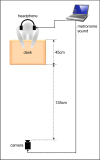Differing Dynamics of Intrapersonal and Interpersonal Coordination: Two-finger and Four-Finger Tapping Experiments
- PMID: 26070119
- PMCID: PMC4466560
- DOI: 10.1371/journal.pone.0129358
Differing Dynamics of Intrapersonal and Interpersonal Coordination: Two-finger and Four-Finger Tapping Experiments
Abstract
Finger-tapping experiments were conducted to examine whether the dynamics of intrapersonal and interpersonal coordination systems can be described equally by the Haken-Kelso-Bunz model, which describes inter-limb coordination dynamics. This article reports the results of finger-tapping experiments conducted in both systems. Two within-subject factors were investigated: the phase mode and the number of fingers. In the intrapersonal experiment (Experiment 1), the participants were asked to tap, paced by a gradually hastening auditory metronome, looking at their fingers moving, using the index finger in the two finger condition, or the index and middle finger in the four-finger condition. In the interpersonal experiment (Experiment 2), pairs of participants performed the task while each participant used the outside hand, tapping with the index finger in the two finger condition, or the index and middle finger in the four-finger condition. Some results did not agree with the HKB model predictions. First, from Experiment 1, no significant difference was observed in the movement stability between the in-phase and anti-phase modes in the two finger condition. Second, from Experiment 2, no significant difference was found in the movement stability between the in-phase and anti-phase mode in the four-finger condition. From these findings, different coordination dynamics were inferred between intrapersonal and interpersonal coordination systems against prediction from the previous studies. Results were discussed according to differences between intrapersonal and interpersonal coordination systems in the availability of perceptual information and the complexity in the interaction between limbs derived from a nested structure.
Conflict of interest statement
Figures















References
-
- Bernstein NA (1996) On Dexterity and Its Development In Latash ML & Turvey MT (Eds.), Dexterity and its development, 3–244. Mahwah, NJ: Lawrence Erlbaum Associates.
-
- Kelso JAS (1984) Phase transitions and critical behavior in human bimanual coordination. American Journal of Physiology—Regulatory 15: R1000–R1004. - PubMed
-
- Kelso JAS (1995) Dynamic patterns: The self-organization of brain and behavior. MIT Press.
-
- Haken H, Kelso JAS, Bunz H (1985) A theoretical model of phase transitions in human hand movements. Biological Cybernetics 51: 347–356. - PubMed
-
- Haken H. Synergetics: An Introduction Nonequilibrium Phase Transitions and Self-Organization in Physics, Chemistry and Biology (Springer Series in Synergetics). Berlin: Springer-Verlag, 1977.
Publication types
MeSH terms
LinkOut - more resources
Full Text Sources
Other Literature Sources
Miscellaneous

